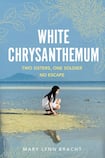
Jeju Island, Korea, 1943. Sixteen-year-old Hana has lived her entire life under Japanese occupation, schooled through a foreign tongue that denies her native language and culture. Like many young women in her village, Hana has left school and embraced her Korean heritage as a haenyeo, a girl or woman who supports her family by diving deep into freezing waters to search for abalone or oysters, the latter a rarity following years of plundering by Japanese seamen.
It is a fitting metaphor for the horrific abuse that follows as Hana is kidnapped from a beach by Japanese soldiers after heroically hiding her younger sister Emi. Mary Lynn Bracht’s debut novel excels at shedding light on a relatively untold story, at least in the Western world, of the thousands of Korean women and girls who were sold into sexual slavery by the Japanese military during Japan’s colonisation of Korea in the second World War. In a detailed author’s note that includes a historical timeline of a war-ravaged country, Bracht outlines the motivation behind the book: to document and draw attention to the horrors so the sins of the past are not repeated.
Although fictional in plot and character, her novel has the starkness of witness literature. It shares with exemplars of the form – Primo Levi's If This is a Man; Rezak Hukanovic's The Tenth Circle of Hell – a simplicity to the prose that lets the events speak for themselves, though there is at times an awkwardness to Bracht's style as she tries to put the atrocities into the voices of her characters while failing to resist an authorial tone.
‘Comfort women’
The plight of Hana and the other “comfort women” nonetheless comes through. Were it not for its barbaric content, the prose style could work well for a young adult audience. The generational impact of war is seen through a second narrator, Emi, who feels the crippling guilt of survivors and has allowed it to determine her life and relationships.
Bracht is well placed to tell this important story. Growing up in Texas with a South Korean mother, the author based White Chrysanthemum on stories from her mother and her community of expat friends who came of age in postwar South Korea. Hana and Emi's narratives chart the historical terrain: "Everyone had suffered during the Japanese occupation of Korea. Many had survived the Second World War only to die in the Korean War."
While Emi looks back from present-day Seoul as she visits her lesbian daughter – one of many narrative strains that touches on female solidarity – and attends the remembrance marches for the comfort women, Hana lives through the horrors. We witness her induction into sex slavery, her internment in a brothel for Japanese soldiers, her escape into the Manchurian wilderness, her refuge with Mongolian peasants and her interrogation by Soviet forces of the future North Korea.
The brothel
Hana’s time in the brothel is the most powerful and unforgettable of these situations: “They eat a meagre meal, then go to bed to start the day again. Ten hours a day, six days a week, she ‘services’ soldiers. She is raped by 20 men a day … They don’t beat her if she lies still on the mat. It is as though they don’t care if she is dead or alive, just that she is physically present so that they can do what they have come to do.”
Bracht peppers her story with interesting historical and cultural detail: the tatami mats the comfort women use; the traditional ger, or sleeping tent, of the Mongolians; the pride the haenyeo women take in their work; the titular chrysanthemum, a symbol of mourning for Koreans; the Sonyeosang, or gold Statue of Peace that Emi recognises at the marches and that was in reality erected as a hard-won apology from Japan. That the details of the abuse were not made public until 1992 make the remembrance of them all the more important.
Where the novel falters is in its fictional drawing of certain characters – particularly the one-dimensional, villainous Corporal Morimoto – and in descriptions that can be both overblown and clunky: "Their struggle is a pantomime on an empty stage, and their one audience member is grinning with wicked pleasure." Characters are "gone in the blink of an eye", or talk of their own home as a "small traditional house". An authorial voice frequently interrupts: "They may be harvesting opium, the plague of China, but that means nothing to Hana." This happens even in the midst of the rape scenes, as Hana thinks of the soldier "tearing her youth to shreds with each thrust".
Where White Chrysanthemum succeeds is in its careful selection of historical events that combine to make an action-packed novel with a clear instructive purpose. It is an ode of remembrance to Korean women that recalls Kipling's famous line, "Lest we forget – lest we forget."











